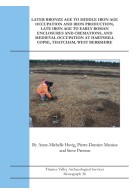Medieval Occupation and a 17th-Century Tobacco Pipe Kiln at 22 to 26 Spital Street, Dartford, Kent (Paperback)
Imprint: Thames Valley Archaeological Services
Series: TVAS Monograph Series
Pages: 94
ISBN: 9781911228257
Published: 5th March 2018
Script Academic & Professional
Series: TVAS Monograph Series
Pages: 94
ISBN: 9781911228257
Published: 5th March 2018
Script Academic & Professional
Usually available in 6-8 weeks.
You'll be £12.00 closer to your next £10.00 credit when you purchase Medieval Occupation and a 17th-Century Tobacco Pipe Kiln at 22 to 26 Spital Street, Dartford, Kent. What's this?
+£4.99 UK Delivery or free UK delivery if order is over £40
(click here for international delivery rates)
Order within the next 4 hours, 57 minutes to get your order processed the next working day!
Need a currency converter? Check XE.com for live rates
(click here for international delivery rates)
Order within the next 4 hours, 57 minutes to get your order processed the next working day!
Need a currency converter? Check XE.com for live rates
Excavation in advance of commercial development in the heart of Dartford provided evidence for several periods of the site's development. The earliest evidence was Roman: a ditch and a pit, together with residual pottery and coins in later features. The post-Roman occupation begins from the 13th century leading to unbroken use of the site through to the present. The 13th-century use comprised dark earth deposits and three cut features. It was from the mid/late 13th century to late 14th century that occupation began in earnest with the construction of two masonry buildings, one substantial and the other smaller. Both survived as chalk and flint foundations together with chalk and beaten-earth floors. Two stacked-tile hearths in the southern part of the site suggest the presence of another structure. The buildings continued in use into the early-mid 15th century, with internal alterations.
In the mid-late 15th century another building of chalk and flint was constructed close to the frontage of Spital Street, which housed ovens and hearths. In the late 15th or 16th century this building was superseded by another stone-built (or stone-footed) building.
In the 17th century, the nature of the site changed, and a clay pipe kiln was housed in another stone building, providing evidence for the earliest such manufactory from the town.
Other titles in the series...
Other titles in Thames Valley Archaeological Services...










